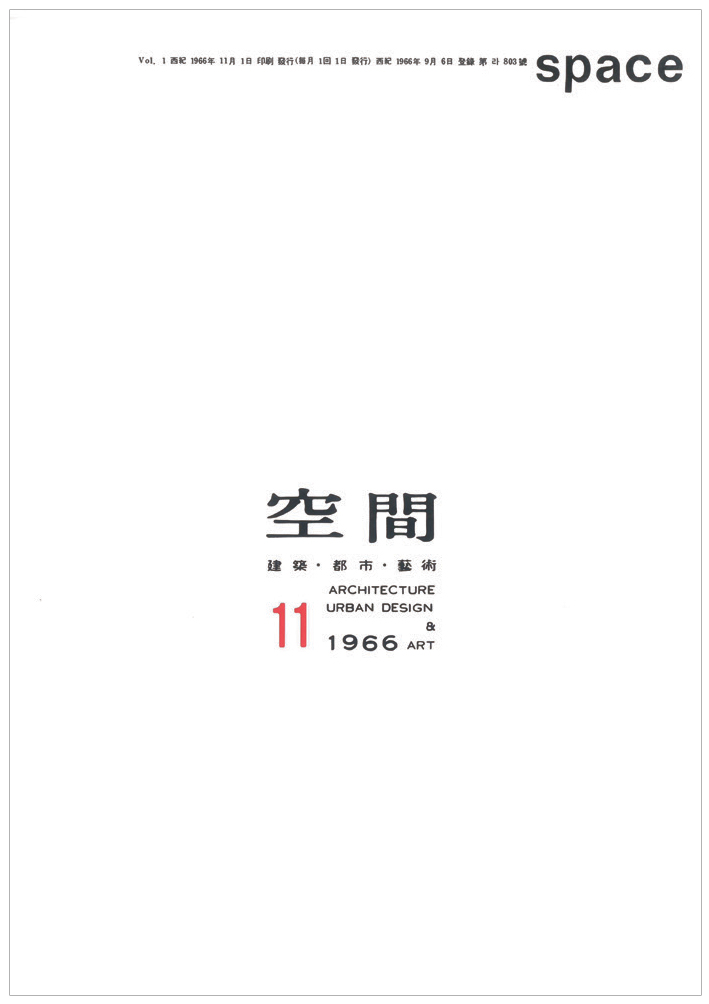
The cover of SPACE No. 1 (Nov. 1966)
The series ‘Re-visit SPACE’ has decided to review the inaugural issue of November 1966. Let’s look back on our journey over the past year through the prism of the starting point of this SPACE magazine. Park Junghyun has partially examined the context of this first publication in Modern Architecture in the Developmental State of Korea (2020), noting that the publisher of SPACE in its earliest days was Sok Chung Sun, an influential figure in the then government, and not Kim Swoo Geun. The ‘A Production Company’, its publishing house, nonetheless shared the same address with the Kim Swoo Geun Architects.▼1 Therefore, it was a rare media outlet that unfolded from the imagination of an individual architect as well as positing the means to promote national projects during its early years. The book emphasises, in other words, that the magazine was created at the point when the needs of the nation and architecture crossed.
In fact, the story behind the foundation can be heard from Kim Won (1943 ‒ ). Kim, who played an operational role in the preparation of the publication, testified to that through his blog posts entitled ‘50 Years of SPACE’ and ‘The Story of the Lieutenant-colonel Sok Chung Sun’, uploaded in 2016 around the time of the 50th anniversary.▼2 In the recent interview with the author, Kim told more stories about this moment.▼3 According to him, publishing a magazine was the long held dream of Kim Swoo Geun (1931 ‒ 1986), and with the support of Kim Jong-pil and Sok Chung Sun ‒ presumably the funds of the Korean Central Intelligence Agency ‒ it became possible. Kim Won conveyed the architect’s wording in vivid detail: ‘Hey, I’ve got some money. Let’s make a magazine. It will be a playground in which you can play.’ These were said to Yoon Seungjoong (1937 ‒ ) and Kim Won, but the role, which tended to be comprised of odd jobs, was assigned to Kim Won. His name could not dare to be included in the ‘editorial staff’ list. At that time, Kim Swoo Geun was 35, and Kim Won was 23 years of age. They were young men. Kim Won remembered that they prepared the first publication from October 1965, which means it took around a year to complete the groundwork.
Kim Swoo Geun suggested three guidelines: first, that ‘it deals with originals’, which means it does not copy from foreign magazines; second, ‘it will be the magazine that we see, not read’, from which one can understand what is conveyed even without reading text; third, ‘we made a highbrow magazine’, one which is collectable and high- end. The evaluation of each guideline and their achievements varies, but from this we can certainly appreciate the ambitions and aspirations of the young Kim Swoo Geun. Meanwhile, the magazine’s title, SPACE, was the result of an in-house competition. ‘Spazio Humanus (Human Space)’ Kim Won suggested had been selected for the title of the magazine, which satisfied Kim Swoo Geun, but this was shortened to SPACE. It is different from the vague assumption that Kim Swoo Geun may have proposed the word and concept of ‘space’ from the beginning. ‘Architecture, Urban Design & Art’, which was the subtitle from the first to the 100th issue (Sep. 1975), reveals the scope of the magazine in respect of the content.▼4 It seems that it was the cover design over which they scratched their heads for the inaugural issue as well as the title. In the end, the cover was left blank in white with minimal information. It expressed their determination to publish any pictures, images, or writings in the future.
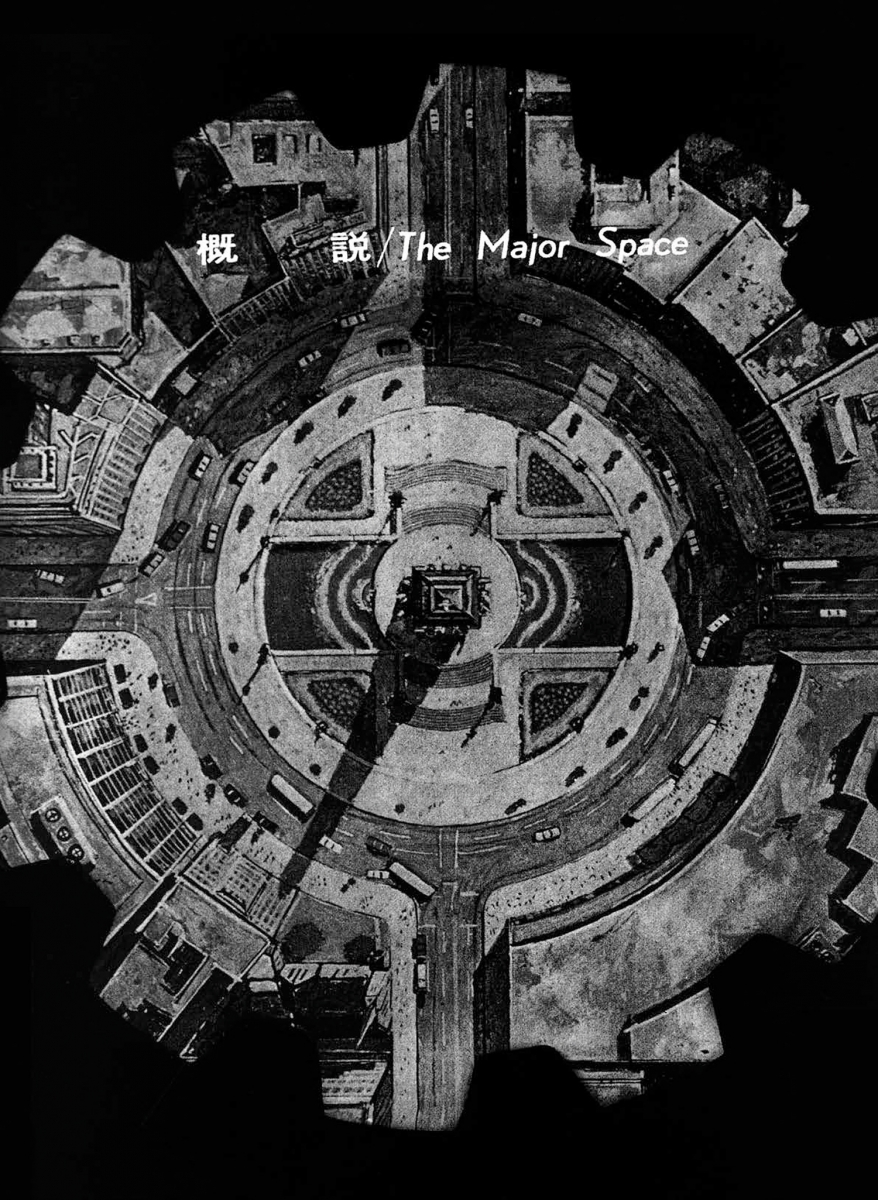
The opening page of outline ‘The Major Space’, SPACE No. 1, p. 18.
Then, what was featured in the inaugural issue of SPACE? The pages of the first issue were filled with ‘Space Photography’ by Limb Eung Sik; ‘Review of the Seoul Urban Planning Exhibition’ of Park Byungjoo; a feature on ‘The Major Space’; ‘A Basic Introduction to Space’ by Lee Haesong; articles on Jongmyo Shrine, Greek architecture, traditional Korean arts, and contemporary art; and domestic and international news, book reviews, market prices of building materials, and advertisements. Among these, we ought to focus on ‘The Major Space’, which was set as a special feature. That is because
it necessarily includes the magazine’s governing intentions since there is no editorial in the inaugural issue. Kim Won said that this topic has already been decided by Kim Swoo Geun and speculated that it was recommended by Park Rhaikyong, who penned a series of ten articles entitled ‘Greek Architecture to Bauhaus’ from the inaugural issue.▼5 ‘The Major Space’, published in two instalments, was the translation of featured articles in the June issue of the American magazine Progressive Architecture (hereinafter P/A) in 1965.▼6 Although the reproduction of such foreign articles may go against one of the guidelines—to deal with originals, it is presumed that if the magazine title were decided as ‘space’, it would have been necessary to cover issues related to space in some way.
The term ‘major space’ can be understood as a common noun: ‘large space’. It is a term that P/A assumed and used to suggest ‘building[s] whose dominant part is a single room’, that is, ‘major-space buildings’. As one might notice from one of the articles, the major space includes exterior spaces in addition to the interior ones. P/A chose this theme to explore the meaning of the large modern space in terms of a psychological aspect as well as a functional one. As background to this, there was a need to consider a new spatial concept according to the advent of the space age, but there also lay regret about the demolition of Pennsylvania Station in New York (1963), which had a ‘large space’. It is questionable that the intentions of P/A were consistent with the direction of SPACE and with the Korean context. However, it is significant that Lee Haesong’s ‘A Basic Introduction to Space’, on behalf of SPACE, came to highlight the psychological role of ‘major space’, while it reaffirmed the essence of architecture is on ‘the formation of space’. Also, Lee meaningfully pointed out that the spatial composition in the East is characterised by an ‘arrangement of exterior spaces’ rather than a ‘major-space-like interior space’ in the West. This is an effort towards an appropriation of a translated concept. These efforts also continued into the SPACE No. 2 (Dec. 1966), in which the second half of ‘The Major Space’ was published. A conversation between Han Changjin and Lee Kyungsung, entitled ‘The Major Space for Today’, was added to stress the necessity for architectural space like ‘grand plaza’ as ‘major space’ in which our community can gather and engage with one another. Here, Lee Kyungsung exalted the Freedom Center (1963 ‒ 1964) designed by Kim Swoo Geun as the domestic ‘masterpiece of major space’. Some readers, who are only accustomed to his SPACE Group of Korea Building (hereinafter SPACE Building) of the 1970s, may find this emphasis upon the ‘large space’ a little unfamiliar. However, we need to remember that Kim Swoo Geun of this time still had to work on the large project of the Korea Engineering Consultants Corporation (KECC) and to survive the ‘Japanese-Style Scandal’ of the Buyeo Museum. Also, Kim Swoo Geun of this time was yet to conceive ‘Ultimate Space’ and ‘Womb Space’, even though the ‘major space’ was applied to the SPACE Building with a compact composition.▼7
‘The Major Space’ also relates to the other articles in the inaugural issue. It was suggested that ‘A Basic Introduction to Space’ is a kind of explanation for this topic. However, one might be curious that the 20-page pictorial feature on Jongmyo Shrine was inserted between the two articles. Perhaps, this editorial gesture was intended to underscore Jongmyo as an example of traditional architecture that embraces ‘major space’, not just to show off the beauty of the Shrine itself. The same intention can be found in the pages of ‘The Major Space’ with whole-page images of the Jongmyo Shrine and Bulguksa Temple, which had not featured in P/A. The photos of Limb Eung Sik, which adorns the beginning of the magazine, do not seem to be necessarily combined with the ‘major space’ even though the first image is the partial photo of the Freedom Center that can be associated with it.▼8 Rather, his aerial photos of the city centre and residential areas of Seoul relate to the following article on ‘Seoul Urban Master Plan’. The latter includes discussions about the ‘New Seoul Plan’ in the shape of Mugunghwa (Rose of Sharon), which drew public attention, confirming that urban planning was the main target of SPACE. Following ‘architecture’ and ‘urban design’, articles about ‘art’, emphasised by the subtitle, could not be omitted. While ‘Tradition and Transmission of Korean Art’ by Chin Hongsop and ‘Reflection on Traditional Korean Art’ by Kim Cholsun addressed the issues of the succession of tradition, ‘Experiential Avant-garde Art of Korea’ by Park Seo-bo and ‘Profile’ of Chun Sungwoo traced the present conditions in Korean contemporary art. ‘News’ and ‘Book Reviews’ also introduced domestic and international news and publications across genres of architecture, urban design, and art.
It is evident that the inaugural issue set the coordinates of the magazine for the future. It clearly showed its desire to traverse East and West, past and present, aiming at a modern creation of architecture, urban design, and art. Though seemingly rather marginal, the profile of Park Gilryong could not be published due to the lack of research, as noted in the ‘Editor’s Postscript’; however, it expanded into the feature ‘Architect Park Gilryong’ in SPACE No. 6 (Apr. 1967). Meanwhile, it is necessary to further examine how meaningful the ‘major space’ covered in the inaugural issue has been to the shaping of the Korean architecture scene in the decades since. The importance of this cannot be overlooked in terms of the genealogy of the early Kim Swoo Geun school, since the concept often appeared in Kim’s own language▼9 and became clearer in Yoon Seungjoong’s idea of dang ‒ literally ‘a house’ or ‘a big space between rooms’ ‒ which is his Korean translation of ‘major space’.▼10 There is also another possibility ‒ although it is a rough assumption ‒ that the ‘exterior space’ discussed in relation to the ‘major space’ stimulated Ahn Youngbae’s serialised articles in SPACE, entitled ‘Exterior Space in Korean Architecture’, from 1974 to 1975. The juyo-gonggan ‒ literally ‘main space’ ‒ was one of the key issues in the articles, and it came to be translated into ‘major space’ in English when the eponymous book was published in 1978. Ahn Youngbae was one of the contributors to the inaugural issue—he introduced Ludwig Hilberseimer’s The Nature of Cities (1955) in the Book Reviews section. The meaning of the inaugural issue of SPACE reached out in various ways. What would also be meaningful is the fact that it was a playground for the young architect Kim Won to develop his muscles as a critic. (written by Hyon-Sob Kim / edited by Bang Yukyung)
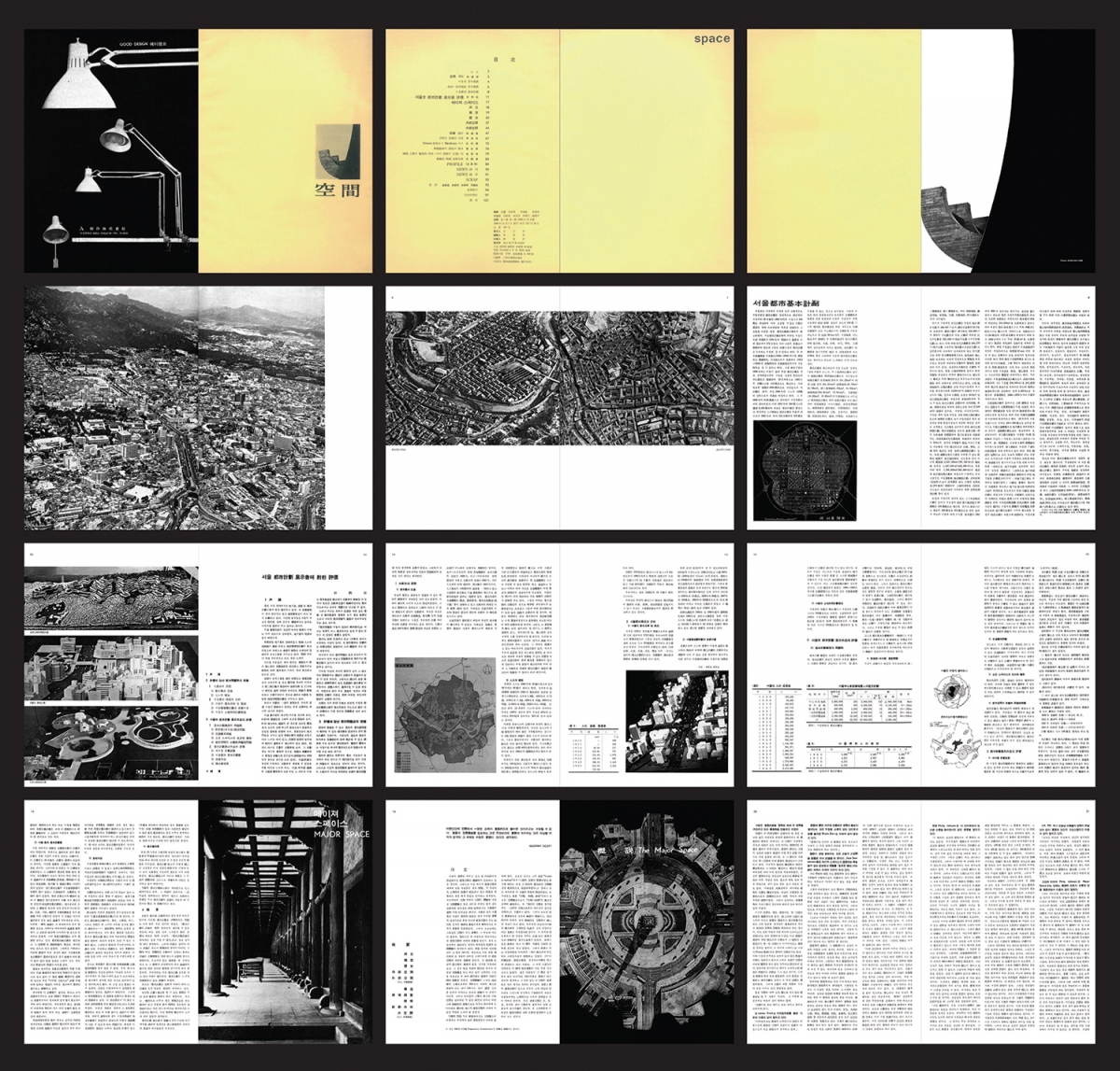
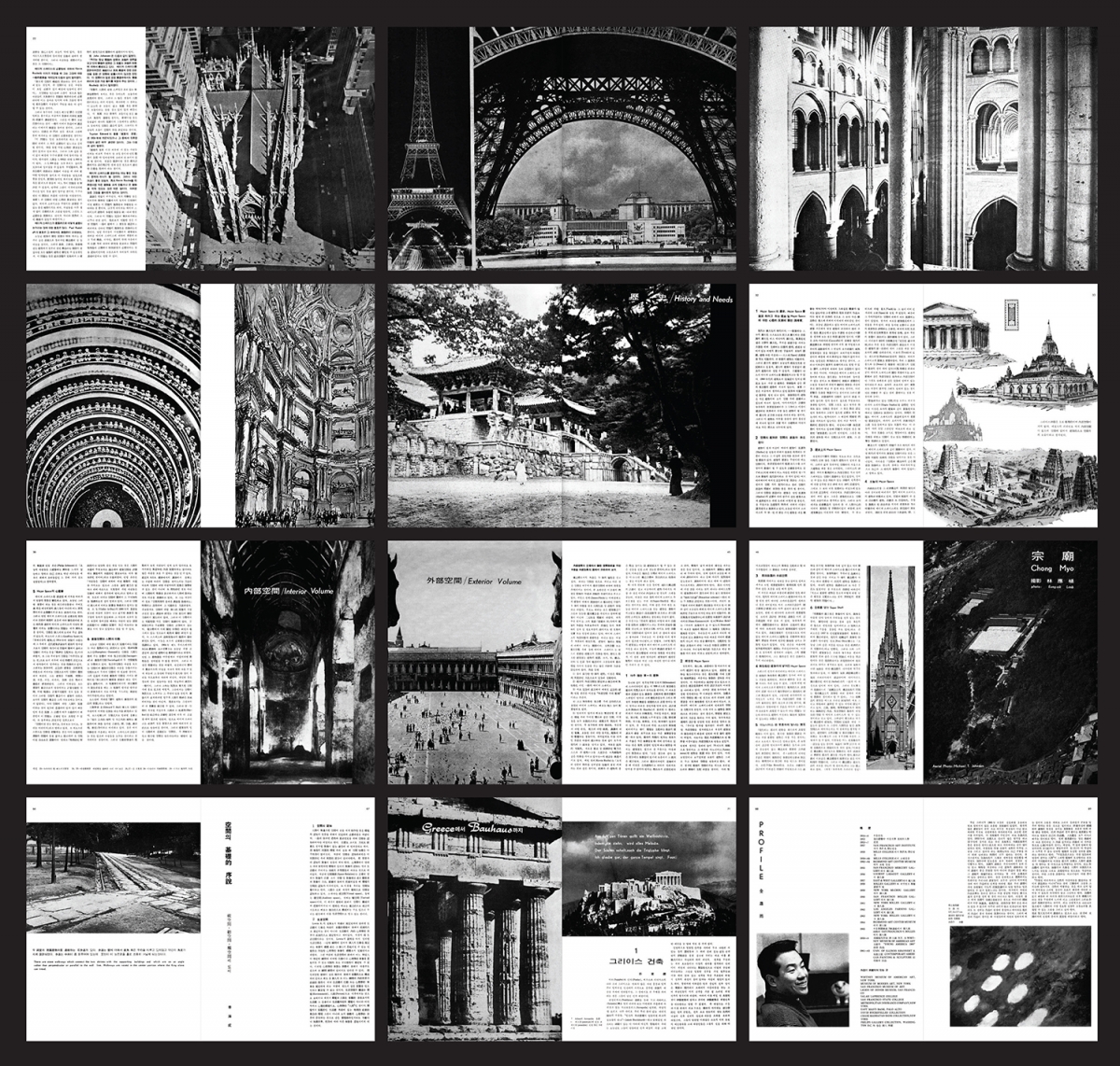
(top) Layout of the inaugural issue of SPACE (from title page to p. 21) / (bottom) Layout of the inaugural issue of SPACE (pp. 22 ‒ 33; 36 ‒ 37; 44 ‒ 47; 66 ‒ 67; 70 ‒ 71; 88 ‒ 89)
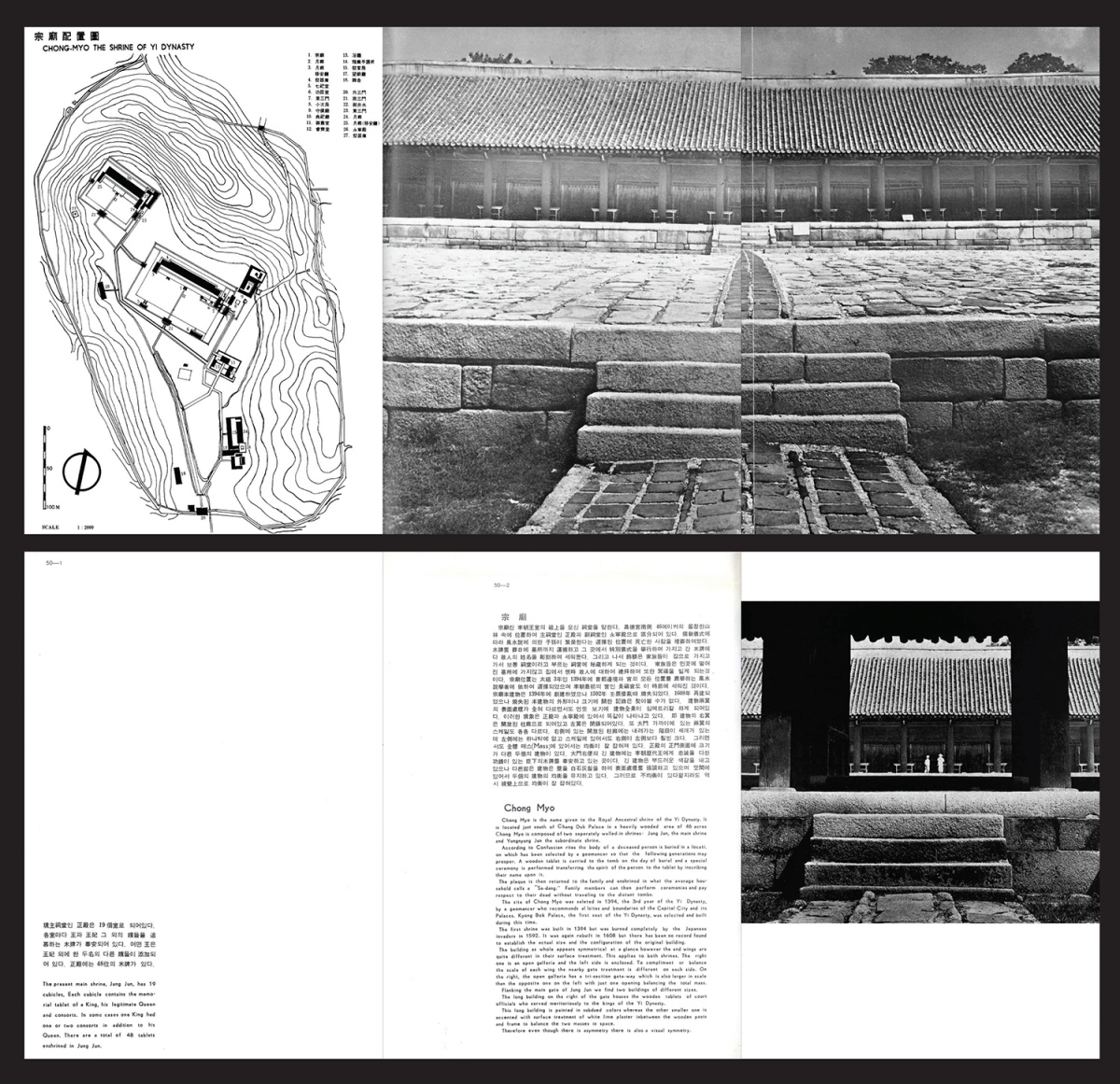
Spread layout of pictorial feature ‘Jongmyo Shrine’ with a folded paper. The inaugural issue of SPACE indicated the page numbers of the folded pages (four pages) as 49-1 and 49-2 on the front side and 50-1 and 50-2 on the back side.
In our next issue, Park Junghyun will cover ‘Seoul 1967’, which featured in SPACE No. 11 (Sep. 1967).
-
1 It is difficult to distinguish between Kim Swoo Geun Architects (KSGA) and Korea Engineering Consultants Corporation (KECC) at that time, but the statement by Park Junghyun, ‘the address of Kim Swoo Geun Architects and the one of Korea Engineering Consultants Corporation is the same’ (p. 53), seems to be an error. As an advertisement for KECC in the inaugural issue says, the address of KECC at that time was ’25, Sinmun-ro 1-ga, Jongno-gu, Seoul’, which is different from ’60, Songhyun-dong, Jongno-gu, Seoul’, the address of ‘A Production Company’. According to the 30-Year History of Korea Engineering Consultants Corporation (1993, pp. 69 ‒ 73), Kukje Industrial Consultant Co., Ltd., the predecessor of KECC, was founded in Songhyun-dong in 1963. However, KECC was launched at the Freedom Center in 1965 and located in Sinmun-ro when SPACE was founded.
2 Refers to Kim Won’s Blog, ‘Gwangjang’ or ‘Kimwon Architects & Group Forum’ (https://blog.naver.com/kimwonarch).
3 The author’s interview with Kim Won at his office Gwangjang (in Dongsung-dong, Jongno-gu, Seoul), the 23th of November, 2021. However, it should also be borne in mind that Kim Won’s memory may be inaccurate at times. For example, the stories that ‘The Major Space’ was published across four issues and that he could write an article under his name after a year had passed are not true. The former was printed in two instalments, and the articles of Kim appeared fromSPACE No. 2 (Dec. 1966).
4 The title and subtitle were written in both Chinese and English letters on the cover of the magazine. From SPACE No. 101 (Oct. & Nov. 1975), the subtitle was changed into ‘Environment, Architecture & Art’ underlining
‘Environment’ though there was a mistake on the cover of SPACE No. 101. The subtitle has further changed afterwards.
5 According to the contributors’ profiles on the inaugural issue, Park Rhaikyong majored in art history in Germany, and Kim Won said that she is the wife of Lee Shin Pok, the first editor of SPACE, in the interview with the author.
6 The June issue of P/A, 1965, includes its editorial on ‘The Major Space’ and an introduction to it by Jan C. Rowan, the editor of P/A, and sub-themed articles by its associate editors and professional contributors – over sixty pages in total (pp. 137 ‒ 200). SPACE omitted the explanation of the topic and the names of original writers.
7 Kim Wonsuk’s concept sketch for the first SPACE Building included ‘major space’. Refer to ‘Re-visit SPACE 1’ covered in SPACE No. 638 (Jan. 2021).
8 Alain Delissen mistook this for the Buyeo Museum. Alain Delissen, ‘The Aesthetic Pasts of Space (1960- 1990)’, Korean Studies 25.2 (2002), pp. 243 ‒ 260.
9 See note 7 and Seung H-Sang, ‘Architect Kim Swoo Geun’, SPACE No. 272 (Apr. 1990), pp. 158 ‒ 165.
10 Refer to the conversation between Yoon Seungjoong and Kim Seokcheol, published in SPACE No. 236 (Apr. 1987) and the one between Yoon Seungjoong, Byun Yong, and Lee Sanghae in Pro Architect 4 (July 1997).




